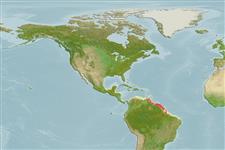>
Pleuronectiformes (Flatfishes) >
Achiridae (American soles)
Etymology: Apionichthys: Greek, apion = pear + Greek, ichthys = fish; it also exists "a-pion", no fatty (Ref. 45335).
Eponymy: Auguste Henri André Duméril (1812–1870), was a physician and zoologist like his father (see next entry) and followed much in his father’s footsteps. [...] (Ref. 128868), visit book page.
More on author: Kaup.
Environment: milieu / climate zone / depth range / distribution range
Ecologia
marinhas; Água doce; estuarina demersal; anfídromo (Ref. 36798). Tropical
Western Atlantic: estuarine areas of the Orinoco (Venezuela), Corantijn (Suriname), Oyapock, Amazon and Grajaú (Brazil) rivers, and from marine areas under influence of these rivers. Enters low land freshwaters - there are records from Jari River (Brazil) and Corantijn River (Suriname).
Tamanho / Peso / Idade
Maturity: Lm ? range ? - ? cm
Max length : 13.1 cm TL macho/indeterminado; (Ref. 80009); common length : 11.0 cm TL macho/indeterminado; (Ref. 5217)
Espinhos dorsais (total) : 0; Raios dorsais (total) : 57 - 75; Espinhos anais: 0; Raios anais : 40 - 55; Vértebras: 34 - 38. Nostril diameter 1.5-2 times orbital diameter; color pattern consisting of a light brown background with irregular, scattered dark brown blotches, the largest ones 2-7 times interorbital space; caudal fin pointed (median rays proportionally longer than external ones); presence of gill openings on both eyed sides; absence of scales on the interorbital space (Ref. 49504).
Rare. Adults occur over sandy-muddy bottoms of the littoral zone and estuaries. Little is known of its biology (Ref. 35237). Maximum length reported to reach 15 cm TL (Ref. 5217).
Ciclo de vida ou comportamento de acasalamento
Maturidade | Reprodução | Desova | Ovos | Fecundidade | Larvas
Ramos, R.T.C., 2003. Systematic review of Apionichthys (Pleuronectiformes: Achiridae), with description of four new species. Ichthyol. Explor. Freshwat. 14(2):97-126. (Ref. 49504)
Status na Lista Vermelha da UICN (Ref. 130435: Version 2024-1)
Ameaça para os humanos
Harmless
Uso pelos humanos
Pescarias: espécies comerciais; Aquário: Espécies comerciais
Ferramentas
Relatórios especiais
Baixar XML
Fontes da internet
Estimates based on models
Preferred temperature (Ref.
123201): 26.9 - 28.1, mean 27.5 °C (based on 102 cells).
Índice de diversidade filogenética (Ref.
82804): PD
50 = 0.5078 [Uniqueness, from 0.5 = low to 2.0 = high].
Bayesian length-weight: a=0.00417 (0.00168 - 0.01037), b=3.10 (2.88 - 3.32), in cm total length, based on LWR estimates for this (Sub)family-body shape (Ref.
93245).
Nível Trófico (Ref.
69278): 3.3 ±0.5 se; based on size and trophs of closest relatives
Resiliência (Ref.
120179): Elevada, tempo mínimo de duplicação da população menor que 15 meses (Preliminary K or Fecundity.).
Fishing Vulnerability (Ref.
59153): Low vulnerability (10 of 100).
